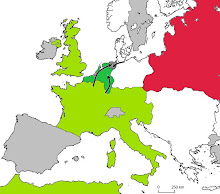 In October 1944, with the advance into southern Germany stalling and German defences in northern France depleted to meet the threat from the allied forces in Austria, the allies decided it was time to launch another front against Nazi Germany. Churchill however was less than enthusiastic at launching another invasion, and the British and Commonwealth forces were in any case committed to the war in the south. Roosevelt therefore agreed that the first landing would be carried out by American forces alone, with Royal Navy support.
In October 1944, with the advance into southern Germany stalling and German defences in northern France depleted to meet the threat from the allied forces in Austria, the allies decided it was time to launch another front against Nazi Germany. Churchill however was less than enthusiastic at launching another invasion, and the British and Commonwealth forces were in any case committed to the war in the south. Roosevelt therefore agreed that the first landing would be carried out by American forces alone, with Royal Navy support.The assault was aimed at western France, where German resistance was weakest. On the morning of the 4th October the US V and VI Corps, along with two airborne divisions, landed near St. Malo, taking the German defenders completely by surprise. The initial advance was therefore swift with Britanny, the Cotentin peninsular and the crucial port of Cherbourg all falling rapidly into allied hands.
By the 8th, the Americans had reached and taken Nantes in a lightning southern dash, while fierce fighting around Caen saw two German armoured divisions massacred before the axis troops withdrew towards a more defensible position on the Seinne.
However, as the Americans pushed further inland they outstripped their supplies, astonished at the speed of their advance. On the 17th they were approaching La Rochelle and reached Le Mans and Tours. It was then that Von Runstedt unleashed his counter attack, utilising Panxer Group West in an assault Hitler had been demanding since the invasion began.
Due to allied air power however the counter attack was a fitful affair, with heavy panzer units often arriving late into the fray. At first it seemed that the counter attack would not bear any fruit, and US airborne divisions looked like taking Tours and continuing their advance. On the 21st however a rapid counter attack by Panthers and, belatedly, Tiger heavy tanks shattered American morale.
While one force moved up from the south near Poitiers another advanced west, retaking Le Mans and surrounding a significant force of Americans near Angers. Here a desperate last defence saw the US forces just able to effect a fighting withdrawal, but the lightning allied advance had come to an end, and the Germans now prepared to drive the allies back towards the coast, aiming to cut their army in France in two. What had started so promisingly now looked in danger of turning into a fiasco.

No comments:
Post a Comment